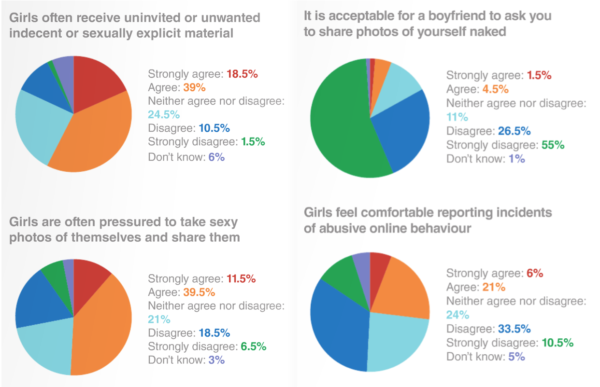A Recent study by Plan International shows an alarming amount of teenage girls are being pressured into sending nude photos or “Sexting”. Almost all surveyed thought it was unacceptable to be asked to send sexting photos, but many of the girls surveyed felt very uncomfortable reporting such solicitations. The survey also showed that many girls were receiving unsolicited indecent or sexual images and video. The girls in this survey wanted more education around this issue, and wanted more education about the influence of pornography on the “normalisation” of such requests.

The survey didn’t say if the unwanted photos and videos came from people the girls knew, but from feedback that I receive from teenage girls at my cyber safety talks many of these approaches come from social media and messaging apps like Kik Messenger, an app with no real privacy settings. Privacy settings that work, and culling unknown followers/friends can cut down the unwanted photos and videos substantially.
Parents clearly need to address this issue of sexting earlier than the teenage years. With some children joining social media underage (13 years is the legal age for social media) and many children being exposed to pornography at an average age now of 11 years of age, some younger children are also seeing this behaviour as sophisticated and cool.
What Can Parents Do To Try To Help Their Kids With This Issue
- Have a conversation about taking photos/video as soon as your child has access to a device that has a camera on it. What is ok to take photos of? When do you need to ask permission? Where will the photo be used or saved?
- Have a conversation about sending/sharing photos as soon as your child has access to a device with SMS or a messaging app. What photos are ok to send, be specific. (It’s ok to limit your child to only sending photos of scenery or pets, many parents have this rule)
- Have another conversation about sending/sharing photos when your child is signing up for a social media app, like Facebook or Instagram. What is ok for them to post?
- If you allow them to send photos of themselves, be specific about where those photos are taken and what the child looks like in them. (Some primary school students are sharing very provocatively posed photos, fully dressed but in poses on their bed etc)
- Find out what apps your child is using, are they public sharing or private? does it have a good safety rating? www.commonsensemedia.org
- Set up privacy settings on the apps they use to share content if they are available.
- Make sure you approve all their friends or followers if they are younger users.
- Let your children know that if they ever receive an inappropriate or rude photo or are asked to send one, to tell you as soon as they can.
- Report any solicitations to your child’s school or the police.
- Delete any nude photos of under age children, do not save them.
Talking to your child about sexting can be embarrassing, finding the right time to do so is important. Keeping a cool head about this issue is vital. If your child is the victim of sexting, or is being sent inappropriate photos the person soliciting the photos must be prevented from doing so again. Although you may feel awkward about going to the police or your child’s school, it may prevent it from happening again or prevent it from happening to another child. It is also very important that your child feels safe in reporting the incident to a responsible adult.
Sending or sharing a nude or semi nude photo of a child under 18years of age is illegal and has very serious ramifications for both the sender and receiver. For more on the legal ramifications of sexting see LawStuff
To find out how to set adult content filters and privacy settings on Facebook, Snapchat, Instagram, Skype and more see my Cyber Safety Manual Here

